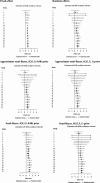Sequential methods for random-effects meta-analysis
- PMID: 21472757
- PMCID: PMC3107948
- DOI: 10.1002/sim.4088
Sequential methods for random-effects meta-analysis
Abstract
Although meta-analyses are typically viewed as retrospective activities, they are increasingly being applied prospectively to provide up-to-date evidence on specific research questions. When meta-analyses are updated account should be taken of the possibility of false-positive findings due to repeated significance tests. We discuss the use of sequential methods for meta-analyses that incorporate random effects to allow for heterogeneity across studies. We propose a method that uses an approximate semi-Bayes procedure to update evidence on the among-study variance, starting with an informative prior distribution that might be based on findings from previous meta-analyses. We compare our methods with other approaches, including the traditional method of cumulative meta-analysis, in a simulation study and observe that it has Type I and Type II error rates close to the nominal level. We illustrate the method using an example in the treatment of bleeding peptic ulcers.
Copyright © 2010 John Wiley & Sons, Ltd.
Figures
Comment in
-
Comments on 'Sequential methods for random-effects meta-analysis' by J. P. Higgins, A. Whitehead and M. Simmonds, Statistics in Medicine 2010; DOI: 10.1002/sim.4088.Stat Med. 2011 Oct 30;30(24):2965-6. doi: 10.1002/sim.4269. Stat Med. 2011. PMID: 21969254 No abstract available.
References
-
- The Cochrane Collaboration. The Cochrane Library. Chichester, U.K: Wiley; 2010. Cochrane Database of Systematic Reviews.
-
- Higgins JPT, Green S, Scholten RJPM. Maintaining reviews: updates, amendments and feedback. In: Higgins JPT, Green S, editors. Cochrane Handbook for Systematic Reviews of Interventions. Chichester, U.K: Wiley; 2008. pp. 31–49.
-
- Simes RJ. Prospective meta-analysis of cholesterol-lowering studies: the prospective pravastatin pooling project (PPP) and the cholesterol treatment trialists (CTT) collaboration. American Journal of Cardiology. 1995;76:C122–C126. DOI: 10.1016/S0002-9149(99)80482-2. - DOI - PubMed
-
- Baigent C, Keech A, Kearney PM, Blackwell L, Buck G, Pollicino C, Kirby A, Sourjina T, Peto R, Collins R, Simes R. Efficacy and safety of cholesterol-lowering treatment: prospective meta-analysis of data from 90 056 participants in 14 randomised trials of statins. The Lancet. 2005;366:1267–1278. DOI: 10.1016/S0140-6736(05)67394-1. - DOI - PubMed
-
- Writer WD, Stienstra R, Eddleston JM, Gatt SP, Griffin R, Gutsche BB, Joyce TH, Hedlund C, Heeroma K, Selander D. Neonatal outcome and mode of delivery after epidural analgesia for labour with ropivacaine and bupivacaine: a prospective meta-analysis. British Journal of Anaesthesia. 1998;81:713–717. - PubMed
Publication types
MeSH terms
Grants and funding
LinkOut - more resources
Full Text Sources




